Very few tribal rug makers include figurative designs in their rugs, although many of their motifs are abstract representations of objects in the natural world. Occasionally small camels, goats, horses, insects or even people are woven into a rug as a sort of whimsy, but this is rare.
In Iran, the lion rugs of Fars are well known, and the war rugs from Afghanistan
have had a lot of publicity. But there is a tradition of pictorial  rugs in Afghanistan
that goes back at least to the 19th century. The early examples that we’ve had have
been wedding rugs, depicting the groom on horseback with bride and bridesmaids on
foot. We have no photographs of our C19 examples, and the later ones have a more
“naive art” feel about them.
rugs in Afghanistan
that goes back at least to the 19th century. The early examples that we’ve had have
been wedding rugs, depicting the groom on horseback with bride and bridesmaids on
foot. We have no photographs of our C19 examples, and the later ones have a more
“naive art” feel about them.
Wedding rug, probably 1950s
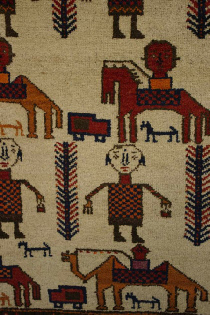
The pictorial rugs are usually described as being from ”near Herat”. Murray Eiland, in Oriental Rugs, identifies the region as Shindand, south of Adraskand, and describes the weavers as being of Persian origin, although there are Baluchi weavers in the area.
Our first encounter with Afghan pictorial rugs was in Herat, in 1972. This rug pictured is in fact one of the two first rugs that we ever bought. It is a very primitive version of the traditional pictorial rugs, and might have been made in an orphanage where children were being trained in the art of rug weaving.
“Naive” rug, ca 1970
Since 1978, the year of the Saur Revolution, Afghanistan has been a war zone. Rifles, guns, helicopters etc started appearing in rugs from many areas. However, the rugs that are known as “war rugs” appear to made in the same tradition as earlier pictorial rugs, with similar wool and weaving. Some seem to be an expression of the emotions of the weavers, but it is possible that many were made to sell to Russian soldiers as souvenirs of their time in Afghanistan. The Russian army was in Afghanistan from 1979 to 1989. We don’t have photos of rugs from this period.
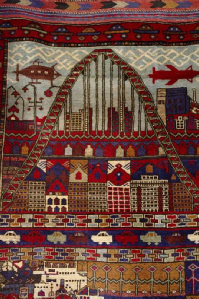 For a brief period, between the departure of the Russians and the takeover by the
Taliban, weavers produced many of what we term “peace rugs”. Some were simply colourful
rugs depicting a map of Afghanistan showing the provinces. The best of them are amazing
visions of what the weavers expected Afghanistan to become -
For a brief period, between the departure of the Russians and the takeover by the
Taliban, weavers produced many of what we term “peace rugs”. Some were simply colourful
rugs depicting a map of Afghanistan showing the provinces. The best of them are amazing
visions of what the weavers expected Afghanistan to become -
“Peace” rug, 1990s
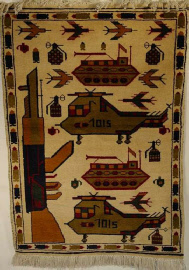 After 2001 there were many “war rugs” made for the market -
After 2001 there were many “war rugs” made for the market -
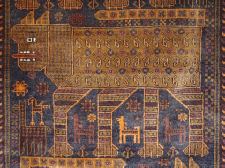 Even within traditional weaving, rug making is not a static art. The weavers are
artists and the art evolves. In the same area of Afghanistan as the production of
pictorial rugs it was possible, in the 1970s, to find what were known as “hunting
banners”, pictures of animals painted on cotton. They were reputed to have some shamanistic
magic, and frequently depicted the native spotted wild cat. By the end of the 1980s,
similar designs started appearing on carpets from the same area. We believe that
the best ones are made by just a few weavers, possibly from just one family. We’ve
bought any that we’ve found, but can only find one or two each year.
Even within traditional weaving, rug making is not a static art. The weavers are
artists and the art evolves. In the same area of Afghanistan as the production of
pictorial rugs it was possible, in the 1970s, to find what were known as “hunting
banners”, pictures of animals painted on cotton. They were reputed to have some shamanistic
magic, and frequently depicted the native spotted wild cat. By the end of the 1980s,
similar designs started appearing on carpets from the same area. We believe that
the best ones are made by just a few weavers, possibly from just one family. We’ve
bought any that we’ve found, but can only find one or two each year.
Ref: Oriental Rugs. Murray Eiland. New Yo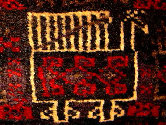 rk Graphic Society. 1973
rk Graphic Society. 1973
Detail, Baluch bag, SW Afghanistan. C19
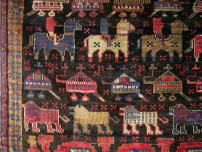 Detail, rug, SW Afghanistan, possibly Baluch weavers. 2nd half C20.
Detail, rug, SW Afghanistan, possibly Baluch weavers. 2nd half C20.
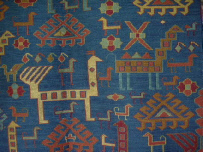 Detail, soumak weave rug, possibly Caucasian motif, woven Afghanistan late C20
Detail, soumak weave rug, possibly Caucasian motif, woven Afghanistan late C20
Afghan pictorial rugs